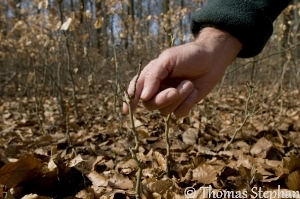Biodiversity Conservation is defeated by Deer

Picture: Browsing in the Keula National Reserve Picture credit: Thomas Stephan (www.thomas-stephan.com) The picture is free for journalistic use only in the context of this press release.
Not in all cases where nature and biodiversity conservation is intended, species protection is the outcome. The ambitious political target e.g. of the German biodiversity strategy to take 5 percent of the forest area out of management, and to produce a wilderness for biodiversity, will lead to the paradox situation of a species loss.
In Thuringia the plan is to take 25,000 ha out of management for conservation. However, without the presence of predators or enough hunting, this will lead to an overpopulation of deer, distorting the desired biodiversity by overgrazing.
In a large scale inventory work German and Romanian scientists have investigated the diversity status of tree regeneration on about 7,000 plots in deciduous forests in Thuringia, Germany, and Romania. The results have just been published in “Annals of Forest Research”. In Thuringia about 50 to 60 percent of the tree species are damaged and subsequently lost by browsing. In Romania the loss is lower with only 10 to 30 percent of the tree species. The damage is largest in protected areas, such as National Parks and Nature Reserves. The deer population is such high, that the pro-tection target gets lost also for organisms other than trees.
“The situation is very severe”, says Ernst-Detlef Schulze, Emeritus Professor at the Max-Planck Institute for Biogeochemistry in Jena, Germany, and lead author of the study. “At this moment we produce monocultures of beech, because – among other reasons – beech saplings are much less damaged by browsing than other tree shoots. “Ecologically the effects are the same as for other monocultures, e.g. spruce forests.”
“We are facing the problem of a very narrow focus of nature conservation” states Dr. Helge Walen-towski of the Bavarian State Institute of Forestry at Freising, Germany. “We will have lots of dead wood but e.g. no butterflies. The loss of tree species results in a loss of insects. Every second butterfly species is going to get extinct; since a specific tree species that is needed for living is being lost as seedling due to feeding of roe deer”.
“The situation will only change, if the legal basis of hunting will be changed” Dr. Laura Bouriaud, Professor for Forest Law at the School of Forestry in Suceava, Romania points out. “There is no rational that hunters have a monopoly on regulating deer populations when the population level runs out of control”.
“The study shows, that only sustainable wildlife and forest management maintains the biodiversity in European forests” says Dr. Dominik Hessenmöller, coworker of the Thuringian Forest Service. “von Carlowitz, who coined the word “sustainable management”, recommended, that a browsed species should be cut, because it will never recover”.
“We were very surprised by our findings. We did not expect such a high damage in Romania” says Dr. Olivier Bouriaud of the Romanian Forest and Management Institute at Bucharest. “In Romania we have wolves and bears and lynx. But a totally new problem emerged in Romania, namely the effects of illegal grazing by domestic goat and sheep, which appears to be highest in protected areas. This however should not obscure the fact that we also have problems with deer, because the wolves prefer to hunt a sheep on alpine grassland rather than a roe deer on steep alpine forest slopes”.
At this moment the high level of damage in conservation areas (National Parks) is only part of the truth. Also managed forests have unacceptable high levels of deer damage to an extent, that the declared management goals of changing monocultures into mixed forest stands is endangered.
Original publication:
E.D. Schulze, O. Bouriaud, J. Wäldchen, N. Eisenhauer, H. Walentowski, C. Seele, E. Heinze, U. Pruschitzki, G. Dănilă, G. Martin, D. Hessenmöller, L. Bouriaud, M. Teodosiu (2014). Ungulate browsing causes species loss in deciduous forests independent of community dynamics and silvicultural management in Central and Southeastern Europe. Ann. For. Res. 57(2)_-_2014
http://www.afrjournal.org/index.php/afr/article/view/273
http://dx.doi.org/10.15287/afr.2014.273
Contact
Prof. Dr. Ernst-Detlef Schulze
Max-Planck Institute for Biogeochemistry, Jena, Germany
Email: dschulze@bgs-jena.mpg.de
Dr. Olivier Bouriaud
Forest Research and Management Institute, Campulung, Romania
Email: obouriaud@gmail.com
Media Contact
More Information:
http://www.bgc-jena.mpg.deAll latest news from the category: Life Sciences and Chemistry
Articles and reports from the Life Sciences and chemistry area deal with applied and basic research into modern biology, chemistry and human medicine.
Valuable information can be found on a range of life sciences fields including bacteriology, biochemistry, bionics, bioinformatics, biophysics, biotechnology, genetics, geobotany, human biology, marine biology, microbiology, molecular biology, cellular biology, zoology, bioinorganic chemistry, microchemistry and environmental chemistry.
Newest articles

Properties of new materials for microchips
… can now be measured well. Reseachers of Delft University of Technology demonstrated measuring performance properties of ultrathin silicon membranes. Making ever smaller and more powerful chips requires new ultrathin…

Floating solar’s potential
… to support sustainable development by addressing climate, water, and energy goals holistically. A new study published this week in Nature Energy raises the potential for floating solar photovoltaics (FPV)…

Skyrmions move at record speeds
… a step towards the computing of the future. An international research team led by scientists from the CNRS1 has discovered that the magnetic nanobubbles2 known as skyrmions can be…





















